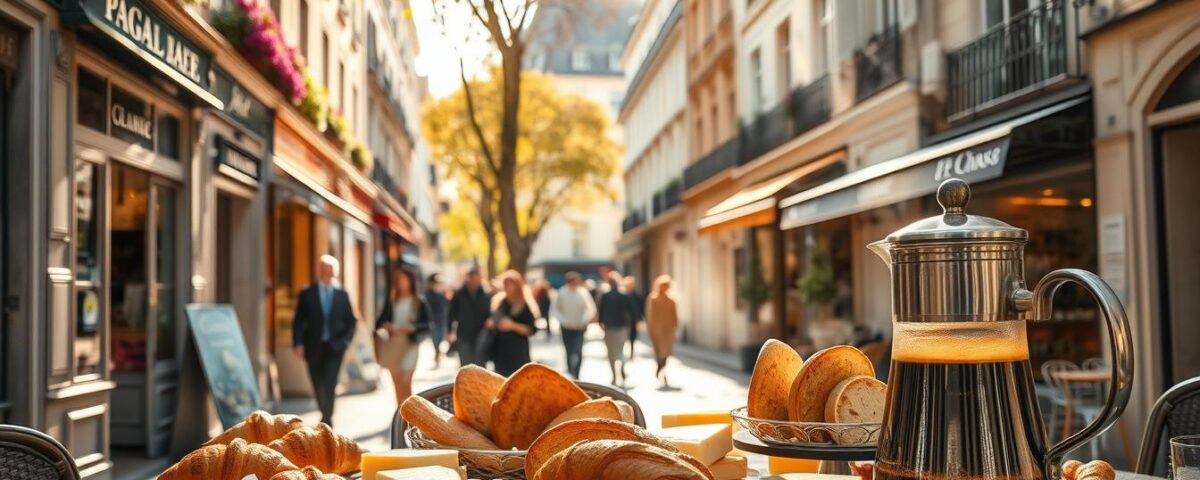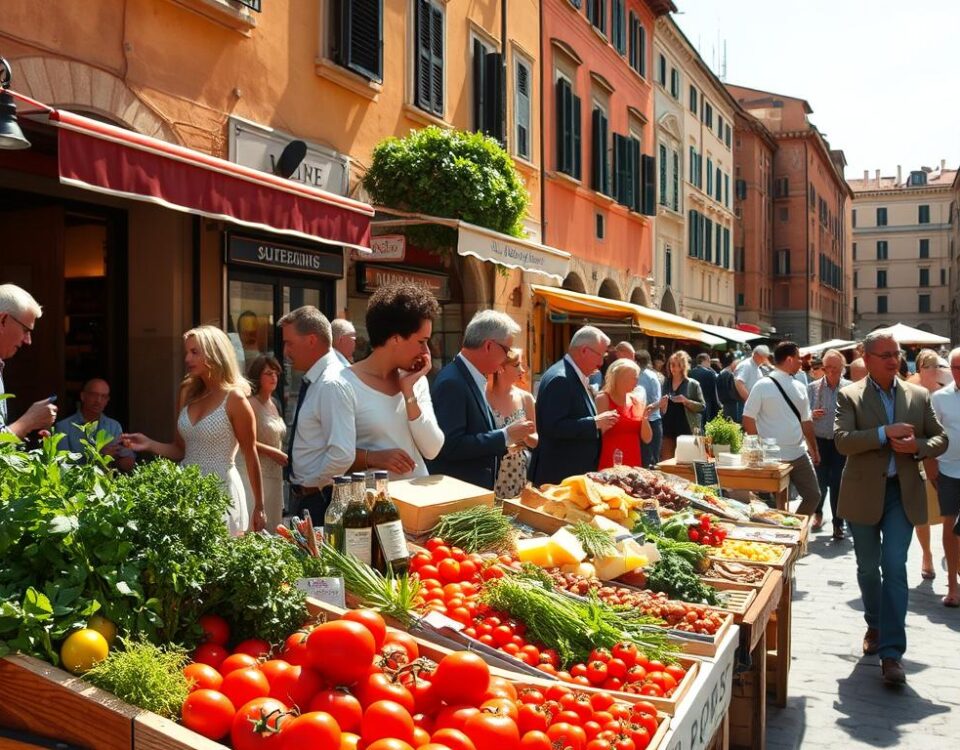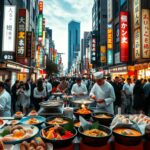
5 Must-Try Dishes You Can Only Find in Tokyo
June 5, 2025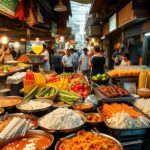
7 Local Foods You Can’t Miss When Visiting Bangkok
June 5, 2025Did you know 80% of visitors to the City of Light never venture beyond three iconic spots for their meals? Last spring, I set out to break that pattern. Armed with recommendations from chefs and locals, I mapped a 12-hour culinary journey through cobblestone alleys and bustling markets—all to prove you can connect with a city’s heartbeat in a single day.
My adventure began at sunrise with the scent of butter-crusted croissants wafting from a tucked-away boulangerie. By noon, I’d nibbled creamy cheeses at a family-run fromagerie and sipped velvety hot chocolate where Hemingway once wrote. What surprised me most? How every flavor felt like a conversation with generations of passionate artisans.
This guide isn’t just about checking boxes. It’s a carefully woven tapestry of time-tested traditions and modern twists, designed for travelers craving depth over duration. You’ll discover how to:
Key Takeaways
- Navigate both iconic landmarks and hidden neighborhood gems efficiently
- Pair classic dishes with contemporary interpretations for contrast
- Engage with vendors and chefs to uncover personal stories behind recipes
- Balance indulgent tastings with lighter fare to maintain energy
- Capture the essence of local culture through strategic timing and route planning
Morning Beginnings in the Heart of Paris
6:47 AM: My watch glowed as I followed buttery aromas down sleeping streets. At this hour, the city’s soul reveals itself through crackling baguettes and the soft thud of dough hitting marble counters. I reached a bakery where golden light spilled onto the pavement, framing loaves like edible sculptures.
Sunrise at a Local Bakery
The chef’s hands moved with practiced rhythm as he slid croissants from the oven. “This butter ratio,” he grinned, “hasn’t changed since my grandfather’s time.” My teeth sank through flaky layers of a pain au chocolat still warm from the heat. Nearby, regulars debated which marmalade paired best with sourdough – a delicious argument I gladly joined.
Fresh Pastries and Coffee Rituals
Three streets over, I discovered a bistro where espresso cups clinked to a 7:30 AM beat. The barista shared her tips while steaming milk: “Come before eight, and we’ll always have time to chat.” I learned to order un café allongé with a twist – a dunkable madeleine on the side.
Those first two hours taught me more than any guidebook. Watching locals claim their favorite tables, hearing stories about rye blends from Normandy – these moments transform breakfast into a cultural compass. Pro tip: Ask bakers about their bread flour sources. You’ll uncover histories hidden in every crumb.
Discovering a Paris authentic food experience
Wandering past Saint-Germain’s ivy-covered walls, I stumbled upon a crimson awning fluttering above baskets of plump strawberries. This became my gateway to understanding how hidden bistros and neighborhood markets shape the city’s culinary identity.

Exploring Hidden Bistros and Markets
A cheesemonger in Le Marais taught me to spot tomme de chèvre with perfect bloom. “Markets are our pantry,” she explained, handing me a sliver aged in hay. Later, joining a food tour revealed bistros where chefs reinterpret grandmother’s recipes – think duck confit tacos served on checkered tablecloths.
At Marché d’Aligre, the air buzzed with vendors shouting “goûtez ça!” (taste this!). I learned why Parisians line up for first-press olive oil and how thyme harvested at dawn changes a stew’s depth. My guide whispered: “The best tips come from those weighing leeks at 7 AM.”
Local Ingredients and Timeless Flavors
One cook demonstrated the ingredients behind her velvety velouté – wild mushrooms foraged near Fontainebleau. “Flavors stick when they’ve got roots,” she said, stirring a pot that smelled like autumn. Through these encounters, I realized French food thrives where tradition meets curiosity.
Blending structured tours with solo explorations created perfect balance. I’d follow a morning market crawl with unplanned stops at bakeries suggested by locals. This approach turned meals into mosaic pieces – each bite revealing part of the city’s story.
Indulging in Iconic French Culinary Classics
Sunlight danced across my linen napkin as silverware clinked around me. This wasn’t just lunch – it was a masterclass in culinary heritage. Across my table sat dishes that have shaped global dining culture, each bite whispering stories of generations.
Signature Dishes That Define a Culture
At La Bourse et La Vie, I discovered why their steak frites became legendary. The chef revealed his secret: “We dry-age the ribeye for 28 days, then baste it in thyme butter.” Paired with golden fries dusted with sea salt, it transformed simple ingredients into art.
From Comfort Food to Elevated Bites
Three blocks away, puffy cheese gougères arrived at my bistro table still warm from the oven. Their delicate crunch gave way to Gruyère’s nutty richness – a perfect contrast to my glass of Burgundy. Nearby, regulars debated which wine complements these airy puffs best.
What makes these classics endure? It’s the marriage of technique and timing. I watched chefs:
- Time sauces to the minute for optimal consistency
- Select cheeses at peak ripeness from local affineurs
- Balance hearty portions with elegant presentation
My most memorable meal came at a tucked-away restaurant where the chef modernized duck à l’orange with blood orange glaze. “Tradition shouldn’t gather dust,” she winked, serving it alongside silky pomme purée. That night, I understood why French flavors never go out of style.
Beyond the Plate: Unique Food Tours and Tastings
At noon, I discovered the city’s pulse beats strongest through its tours. My ordinary walk through Montmartre transformed when I joined a small-group expedition led by a former Michelin critic. “We’re not just eating,” she declared, “we’re decoding centuries of flavor codes.”
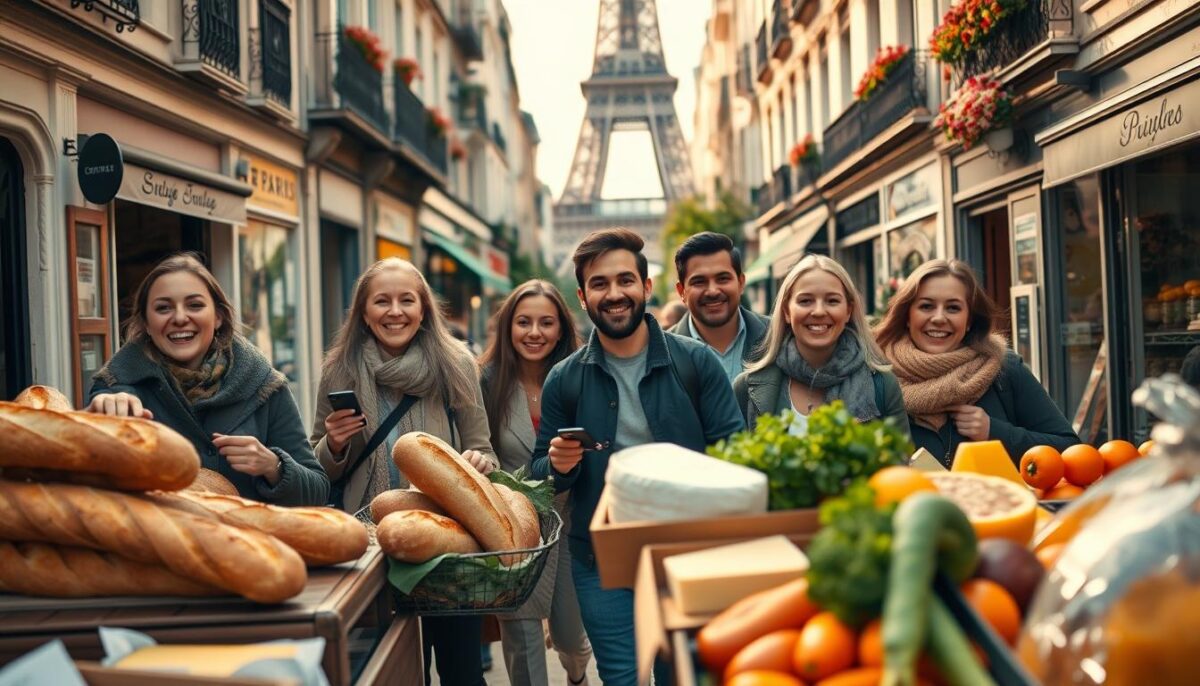
Walking Tours and Neighborhood Adventures
Our group became flavor detectives, tracing stories through cobblestone streets. We tasted:
- Goat cheese aged in chestnut leaves at a fromagerie
- Rosemary-infused chocolates from a master chocolatier
- Bordeaux blends at a wine shop where bottles outnumber customers
The guide revealed how war history shaped baguette lengths and why certain arrondissements specialize in specific pastries. “Every storefront,” she noted, “is a chapter in our edible encyclopedia.”
Meeting Experts and Local Chefs
In a Saint-Germain kitchen, chef Élodie demonstrated canelé baking while sharing trade secrets. “The vanilla? We split pods lengthwise – releases 3x more aroma.” Her hands moved like a conductor’s, transforming simple ingredients into caramelized miracles.
| Tour Type | Duration | Specialty | Group Size |
|---|---|---|---|
| Market Crawls | 2.5 hrs | Seasonal Produce | 6 max |
| Bistro Hops | 3 hrs | Modern Twists | 8 max |
| Pastry Trails | 2 hrs | Technique Demos | 4 max |
These experiences taught me that every bite holds layered histories. By day’s end, I wasn’t just full – I’d gained new lenses for tasting the world.
A Culinary Adventure: Cooking Classes & Workshops
Steel bowls clattered like cymbals as I tied my apron at Alain Ducasse’s cooking school. This wasn’t just a lesson – it was a backstage pass to France’s gastronomic soul. Surrounded by copper pots and marble workstations, I realized knives here aren’t tools; they’re artists’ brushes.
Hands-On Experience at a Michelin-Starred School
Chef Laurent handed me a paring knife colder than a winter morning. “Precision beats speed,” he advised, guiding my shaky cuts on shallots. Our group transformed into a synchronized kitchen ballet – searing duck breasts while emulsifying sauces, all under the watchful eyes of three chefs.
My notebook filled with questions between tasks: “Why chill the dough twice?” “How does thyme harvesting time affect flavors?” The answers came sizzling from pans, not textbooks.
Learning French Cooking Techniques
The real magic happened during tastings. We sampled seven chocolate textures for a single dessert course, discovering how 2°C changes a ganache’s mouthfeel. A wine expert then demonstrated pairings: “Match the sauce’s acidity, not just the protein.”
“Great cooks think in layers – like building a perfume.”
| Class Type | Duration | Focus | Level |
|---|---|---|---|
| Pastry Basics | 3 hours | Laminated Doughs | Beginner |
| Sauce Mastery | 4 hours | Emulsions & Reductions | Intermediate |
| Wine Pairing Lab | 2.5 hours | Regional Matches | All Levels |
As I plated my first tarte tatin, the morning’s chaos crystallized into understanding. What began as a cooking course became a sensory tour through France’s culinary DNA. For travelers craving more than standard food tours, these workshops offer living history lessons – one perfectly flipped crepe at a time.
Experiencing the Local Flavors at Paris Food Markets
Dawn hadn’t yet broken when my alarm buzzed – 4:17 AM felt criminal until I remembered where I was going. Rungis International Market sprawls across 572 acres, supplying 60% of France’s fresh produce. This wholesale behemoth becomes a ghost town by 9 AM, making pre-sunrise tours essential for witnessing its pulsating energy.
Discovering the Rungis International Market
My guide Marcelle swept me past mountains of strawberries still dewy from night harvests. “We move 2.6 million tons annually,” she shouted over forklift beeps. The cheese pavilion alone could fill three football fields – wheels of Comté aging like edible architecture.
What surprised me most? The ballet of negotiation. Wholesalers barked orders while chefs sniffed melons like sommeliers. Marcelle whispered: “That man just bought 300 kilos of chanterelles for twenty Michelin-starred kitchens.”
| Tour Type | Duration | Highlights |
|---|---|---|
| Produce Focus | 3 hours | Seasonal fruits & herbs |
| Meat & Seafood | 2.5 hours | Butchery demonstrations |
| Floral Walk | 1.5 hours | Dutch tulip auctions |
Between crates of Burgundy snails, I grasped how this labyrinth fuels the city’s dining scene. Those bistro ratatouilles? Their eggplants likely rolled through these aisles at 5:32 AM. A flower vendor grinned as she loaded lilies onto a van: “We’re the first brushstroke on every Parisian table.”
By 7:30 AM, I’d walked six miles but gained new respect for culinary culture. The market’s scale could overwhelm, yet every transaction felt personal. Watching guests haggle over apricot varieties revealed what guidebooks miss – the human machinery behind each perfect bite.
Strolling Through Paris: Hidden Gems and Neighborhood Finds
Twilight painted the cobblestones amber when I found a courtyard café humming with whispered recommendations. This wasn’t the tour route – just locals sharing addresses scribbled on napkins. My afternoon became a treasure hunt through passages where flower boxes outnumber street signs.
Secret Cafes and Overlooked Delicacies
A blue door led me to a salon de thé serving lavender-infused madeleines. The baker winked: “We only make twelve batches daily.” Nearby, a cheese shop hid behind a curtain of ivy – their aged Comté paired perfectly with honey from rooftop hives.
Three discoveries defined my stroll:
- A bread maestro crafting rye-loaf sandwiches with truffled chicken
- Artisan chocolate molded into architectural shapes
- Neighbors debating the best duck fat source for potato galettes
My favorite tip came from a bookseller: “Follow the cats – they know where the warm ovens are.” Sure enough, a tabby led me to flaky pastry pockets stuffed with spiced lamb.
These corners pulse with the city’s heart. You won’t find them on maps, but that’s the magic. Each bite feels like sharing secrets with friends who’ve known these streets for decades.
Conclusion
As twilight painted the Seine gold, I realized my culinary mosaic was complete. From dawn’s first croissant to moonlit tarte tatin, each stop wove together like chapters in a flavor-filled novel. What began as a food tour became a masterclass in living traditions – one where every bite held centuries of craft.
Through this journey, I discovered magic in contrasts. Bustling market tastings taught me as much as quiet salon de thé visits. Hands-on workshops with chefs revealed techniques passed through generations, while impromptu street meals showcased spontaneous creativity.
The true richness lies in diversity. Whether sipping wine with sommeliers or debating cheese pairings with vendors, these experiences transformed my trip into cultural immersion. Local artisans became my guide, their passion coloring every flavor.
Let this day-long blueprint inspire your own adventure. Blend structured tours with serendipitous finds – that’s where the city whispers its secrets. When you taste with curiosity, even hours become gateways to the world’s finest gourmet traditions.
Pack your appetite. The flavors await.
FAQ
What’s the best way to start a day of culinary exploration?
I recommend starting at a local bakery at sunrise. Fresh croissants, baguettes, and café au lait set the tone for a day steeped in tradition. The smell of butter and yeast alone feels like a warm welcome.
How do I find hidden bistros locals love?
Wander streets just beyond tourist hubs like Le Marais or Montmartre. Look for handwritten menus, chalkboard specials, and small tables—these spots often serve dishes made with ingredients sourced from nearby markets.
Are cooking classes worth it for a short trip?
Absolutely! I’ve joined workshops led by chefs from Michelin-starred kitchens. Even a 3-hour class teaches techniques like perfecting sauces or crafting soufflés—skills you’ll use long after leaving.
What’s one must-try dish for first-time visitors?
Don’t skip steak frites. It’s simple but transformative when paired with a bold red wine. For something lighter, cheese gougères (airy cheese puffs) are a bite-sized revelation.
Can I explore markets without a guided tour?
Yes, but guides add depth. At Rungis Market, for example, vendors share stories about heirloom produce or rare cheeses you might miss alone. Plus, tastings turn browsing into a full sensory journey.
How do I balance iconic eats with hidden gems?
Mix classics like chocolate éclairs with neighborhood finds. Ask shop owners where they eat—their tips often lead to tucked-away cafés serving caramelized tarte Tatin or silky duck confit.
What’s your top tip for food tours?
Come hungry and curious. Tours like those in Saint-Germain blend history with bites—think crusty bread from centuries-old ovens paired with stories of Parisian life. And always ask questions—chefs love sharing secrets!
